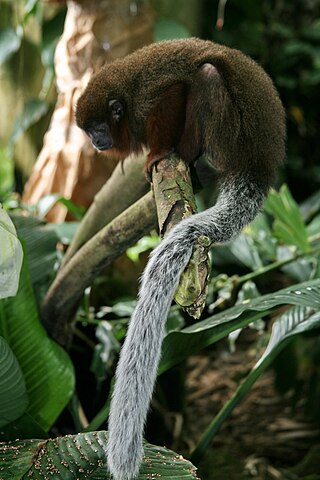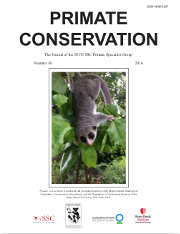Related Research Articles

The gray-bellied night monkey, also called the grey-legged douroucouli or lemurine owl monkey, is a small New World monkey of the family Aotidae. Native to tropical and subtropical forests of South America, the gray-bellied night monkey faces a significant threat from hunting, harvesting for use in pharmaceutical research and habitat destruction.

The Pitheciidae are one of the five families of New World monkeys now recognised. Formerly, they were included in the family Atelidae. The family includes the titis, saki monkeys and uakaris. Most species are native to the Amazon region of Brazil, with some being found from Colombia in the north to Bolivia in the south.

The titis, or titi monkeys, are New World monkeys of the subfamily Callicebinae, which contains three extant genera: Cheracebus, Callicebus, and Plecturocebus. This subfamily also contains the extinct genera Miocallicebus, Homunculus, and Carlocebus.

The black titi monkey, is a species of titi, a type of New World monkey, from South America. It is found in Brazil, Colombia, and Venezuela. It was described in 1811 as Calicebus lugens. It is sometimes called the widow monkey.

The Lucifer titi monkey is a species of titi, a type of New World monkey, from South America. It is found in Brazil, Colombia, Ecuador, and Peru. It was described as Callicebus lucifer in 1914. The Lucifer titi has previously been treated as part of C. torquatus, the collared titi.

The collared titi monkey is a species of titi, a type of New World monkey. It is endemic to northern Brazil.

The white-eared titi monkey also known as the Bolivian titi or Bolivian gray titi, is a species of titi monkey, a type of New World monkey, from eastern Bolivia and an area of western Brazil. The species has a range that extends east from the Manique River in Beni Department, Bolivia to southern Rondônia in Brazil. The southern end of its range includes forests around the city of Santa Cruz de la Sierra.

The Rio Mayo titi monkey is a species of titi monkey, a type of New World monkey, endemic to Peru. The Rio Mayo titi, was thought previously to have a small range of origin in the Alto Mayo valley, but research has proven that the range extends southward and reaches the Huayamba River, as well as Bajo Mayo. It had been classified as vulnerable but due to major habitat loss and restricted living space, it is now classified as Critically Endangered. In October 2012, it was included in The World's 25 Most Endangered Primates list. An increase in deforestation is leading to the decrease in available living space for this titi monkey, forcing it to live in sympatry with another species of Callicebus. Yet in some areas, such drastic deforestation has resulted in extremely high population density. The Rio Mayo titi is better adapted to moderately populated areas, thus overpopulation negatively impacts the species. The forests the Rio Mayo titi lives in are being destroyed for agricultural purposes, leaving little forest for the monkeys. They were only seen a few times and featured in museums until 2003 when more research was done on them. In order for this species to survive, their forests need to be protected to avoid overpopulation. Different conservation groups are working to help P. oenanthe survive. Neotropical Primate Conservation, Proyecto Mono Tocón and Amazónicos para la Amazonia are working in the more southern areas to protect the monkey. The Rio Mayo titi is a fairly inconspicuous creature, making observation and research difficult to obtain. Therefore, the traditional use of transect observation to monitor the monkey's population, is less effective. Instead, other methods of calculating the titi monkey's density in certain areas have been taken, such as research into the species-specific calls endemic to a certain area.

Brumback's night monkey is a species of night monkey found in Colombia. It has traditionally been considered a subspecies of gray-bellied night monkey, Aotus lemurinus. but it has recently been argued that it should be considered a separate species.

The Panamanian night monkey or Chocoan night monkey is a species of night monkey formerly considered a subspecies of the gray-bellied night monkey of the family Aotidae. Its range consists of Panama and the Chocó region of Colombia. There are also unconfirmed reports of its occurrence in Costa Rica, especially on the Caribbean coast of Costa Rica. The species definitely occurs in the Atlantic lowlands of Panama close to the Costa Rica border.

The gray-handed night monkey is a species of night monkey formerly considered a subspecies of Gray-bellied night monkey of the family Aotidae. Its range consists of parts of Colombia and Venezuela. The exact classification of the gray-handed night monkey is uncertain. While some authors consider it a subspecies of the gray-bellied night monkey, A. lemurinus, other authors consider it a separate species, A. griseimembra.

Hernández-Camacho's night monkey is a species of night monkey of the family Aotidae. It was first described in 2007 by Thomas Defler and Marta Bueno. It has a gray neck and a white patch over each eye, separated by a black band. The fur on the chest, belly, lower arms and lower wrists is thick and white. It differs from other gray-necked night monkey species other than Brumback's night monkey in having 50 chromosomes.

The Caquetá titi monkey, also known as the red-bearded titi or the bushy-bearded titi, is a species of titi monkey endemic to Colombia found in the Department of Caquetá region. Taxonomically, it is a member of the "Callicebus cupreus group", following Shunsuke Kobayashi's Callicebus grouping. It was first described by Thomas Defler, Marta Bueno and Javier Garcia in 2010. It is highly endangered due to habitat fragmentation and a small population.
Aotus dindensis is an extinct species of New World monkeys in the genus Aotus from the Middle Miocene. Its remains have been found at the Konzentrat-Lagerstätte of La Venta in the Honda Group of Colombia.

Primate Conservation is a journal published by the IUCN Species Survival Commission's Primate Specialist Group about the world's primates. First published as a mimeographed newsletter in 1981, the journal today publishes conservation research and papers on primate species, particularly status surveys and studies on distribution and ecology. Besides these regular papers, the journal has also been a significant place for primatologists to publish descriptions of new primate species in Primate Conservation.
Lagonimico is an extinct genus of New World monkeys from the Middle Miocene. Its remains have been found at the Konzentrat-Lagerstätte of La Venta in the Honda Group of Colombia. The type species is L. conclucatus.

Plecturocebus is one of three genera of titi monkeys.
References
- 1 2 3 "Thomas R. Defler" . Retrieved 2012-08-17.
- 1 2 Defler, T. (2004). Primates of Colombia. Conservation International. ISBN 978-1-881173-83-0.
- ↑ Semple, K. (2000), A habitat held hostage
- ↑ "In Colombia, activist works to preserve monkeys". Los Angeles Times . July 10, 2010. Retrieved 2012-08-17.
- ↑ Defler, Thonas; Stevenson, Pablo, eds. (2014). The Woolly Monkey: Behavior, Ecology, Systematics, and Captive Research (Developments in Primatology: Progress and Prospects). Springer. ISBN 9781493906963.
- ↑ Defler, Thomas R.; Bueno, Marta L. (2008). "Aotus diversity and the species problem". Primate Conservation. 22 (1): 55. doi: 10.1896/052.022.0104 . 136211.
- ↑ Defler, Thomas R.; Bueno, Marta; Garcia, Javier (2010). "Callicebus caquetensis: A new and critically endangered titi monkey from Southern Caquetá, Colombia". Primate Conservation. 25: 1–9. doi: 10.1896/052.025.0101 . S2CID 83583912. 136211. Archived from the original on 2011-07-26.
- ↑ "Newly discovered monkey nearly extinct". NTDTV. Archived from the original on 2013-04-15. Retrieved 2012-08-17.
- ↑ Moseman, A. (August 13, 2010). "Rare Redbearded Monkeys Found Living in Colombia". CBS News . Retrieved 2012-08-17.
- ↑ Defler, T. (2004). Primates of Colombia. Conservation International. pp. 252–266. ISBN 978-1-881173-83-0.